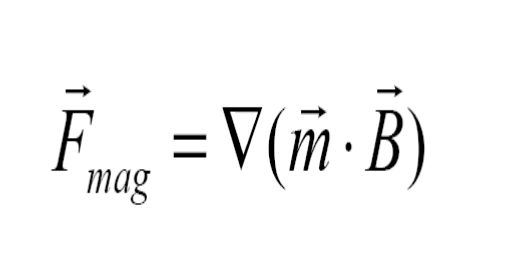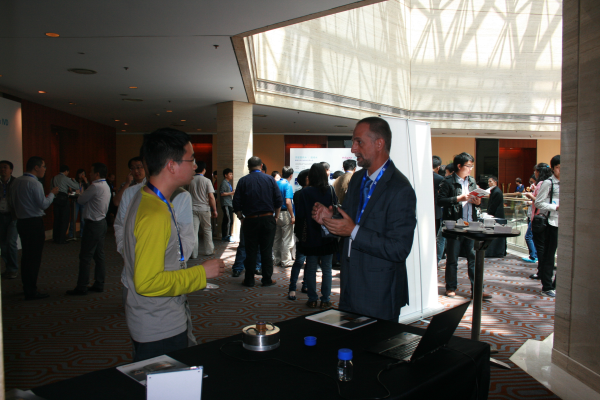
A few days ago I was invited by Merck Millipore to contribute to the Forum they organized in Shanghai. Besides being one of the speakers –more details below-, SEPMAG has also been involved as sponsor. We believed the direct contact with IVD-magnetic beads users in China, as well as with the technical worldwide contributors, is the only way to still push forward this technology.
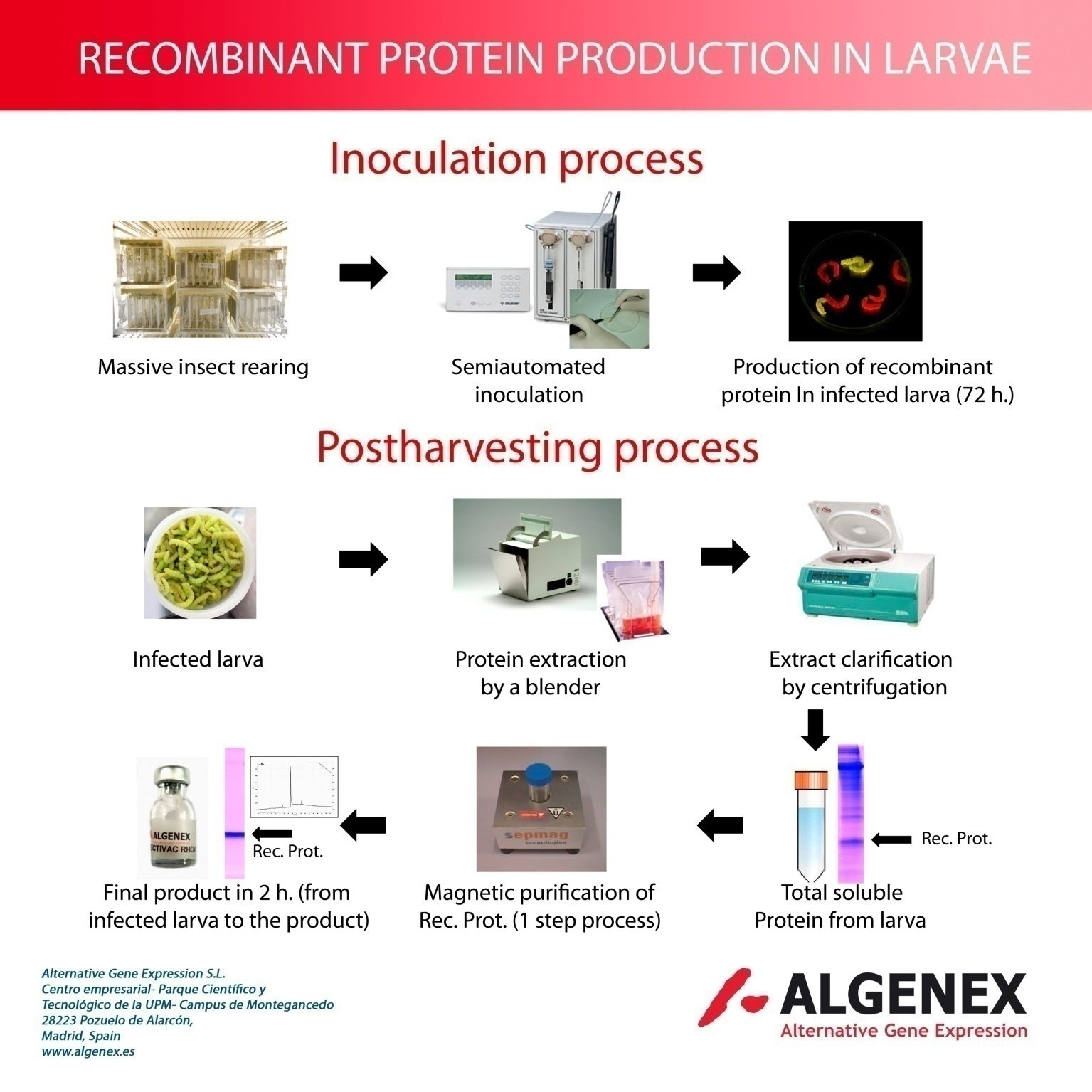
The business value of potentially large production capacities coupled to lower capital expenditures (CapEx) requirements and manufacturing costs may reduce the gap between production volumes and patient needs for potentially life-saving drugs. This is the reason because pharmaceutical companies are continuously seeking for new technologies. An economically efficient alternative to bioreactor-based technologies is the use of living biofactories such as transgenic animals, plants or insects.

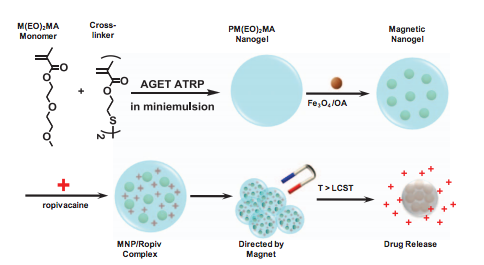
Devising a safe and efficient protocol for using magnetic nanoparticles to target drug delivery is an ongoing challenge whose study has yielded promising results. While the majority of these studies have been focused on delivering cytotoxic drugs to cancer cells, there is a range of possible applications for which targeted delivery could prove invaluable.
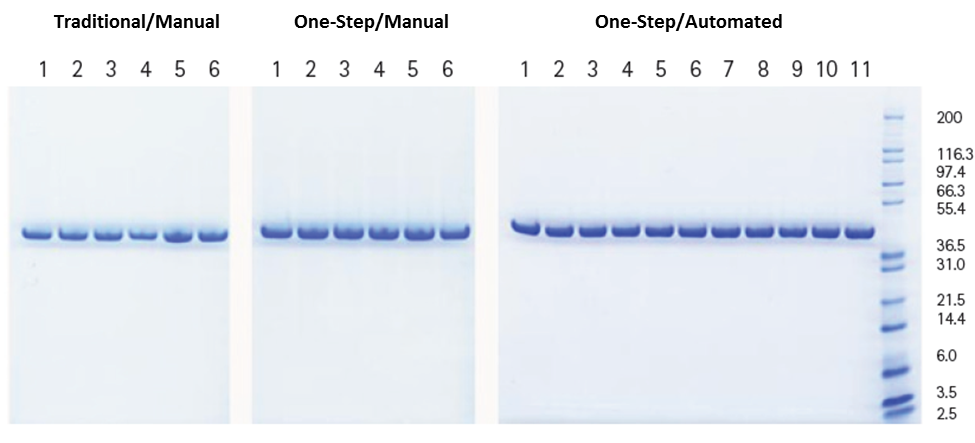
A need for rapid, reproducible, small-scale purification
For many recombinant protein applications, such as expression clone screening and for optimizing expression conditions, there is a crucial need for a rapid, reproducible, small-scale purification process. Traditionally, protein purification from E. coli consists of four distinct phases: harvest, bacterial cell lysis, lysate clarification and protein purification. You will find the whole process explained step by step in our protein purification handbook.

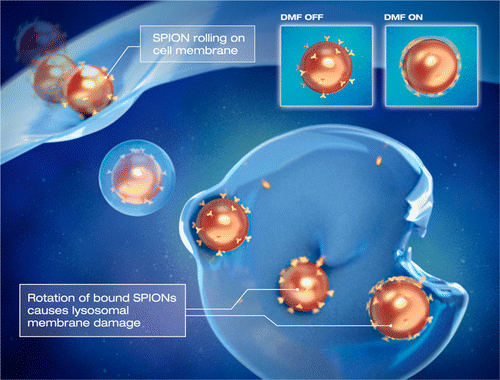
The necessity of finding a safer and more efficient way to treat cancer has led investigators to naturally turn their attention toward nanoparticles. Recently, a group of researchers in Sweden has come up with a novel system of utilizing magnetic particles to trigger apoptosis, thus resulting in the self-destruction of tumor cells. The findings, published in the journal ACS Nano, signify a promising approach to cancer treatment, with implications extending beyond oncology and encompassing a range of clinical applications.
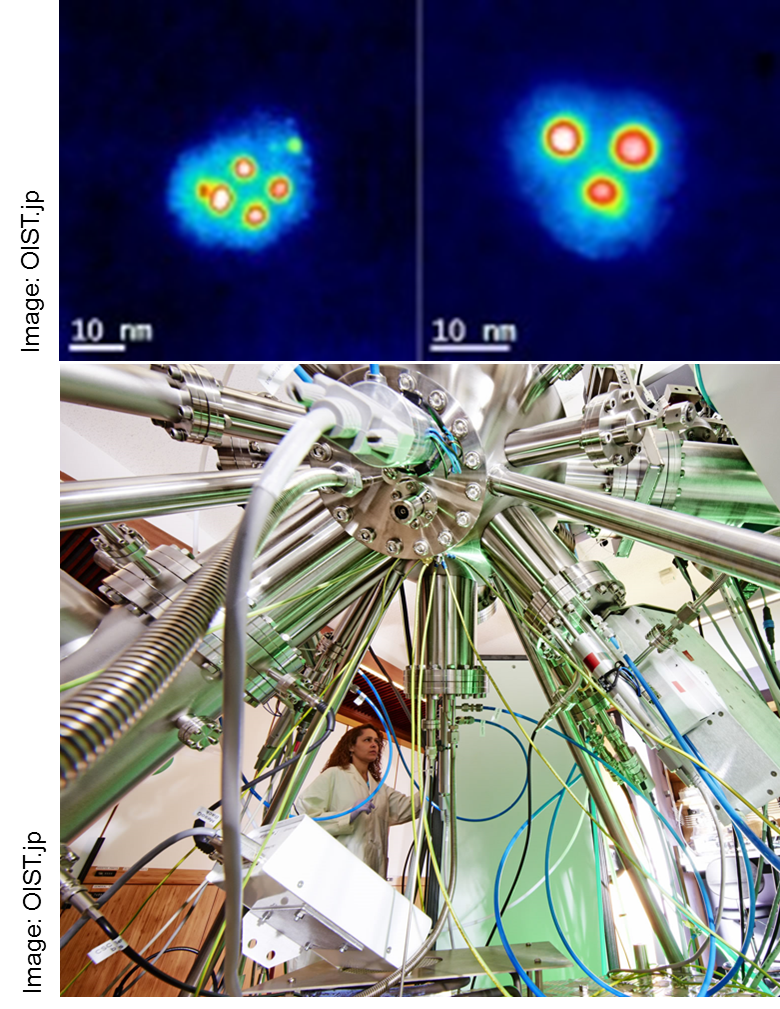
Investigators at the Okinawa Institute of Science and Technology (OIST) in Japan have developed a protocol for manufacturing biocompatible hybrid nanoparticles. The resulting particles have magnetic as well as optical properties. They are suitable for clinical use and can be customized for utilization in a wide range of applications.
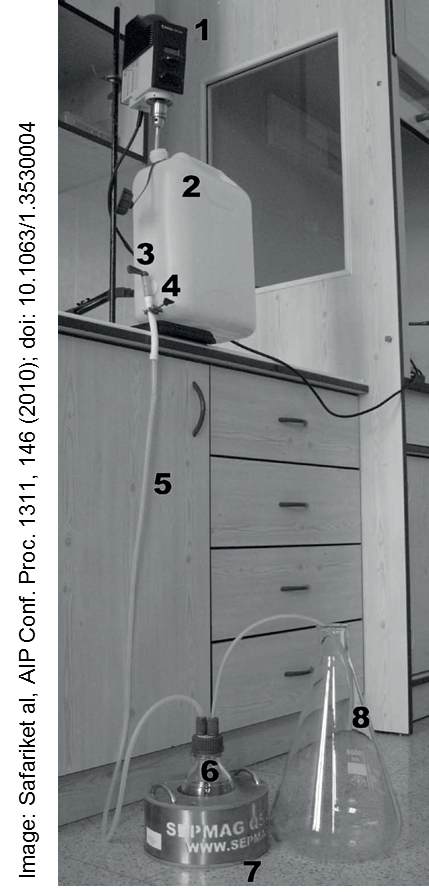
The search for alternatives to chromatographic resins is not new. With the continuous increase in expression levels in recombinant protein purification, columns are struggling with crude lysates. The need to clarify suspensions containing high levels of expressed protein for post-purification re-concentration no longer appears to be the most efficient strategy. You will find much more information about this topic in our protein purification handbook.

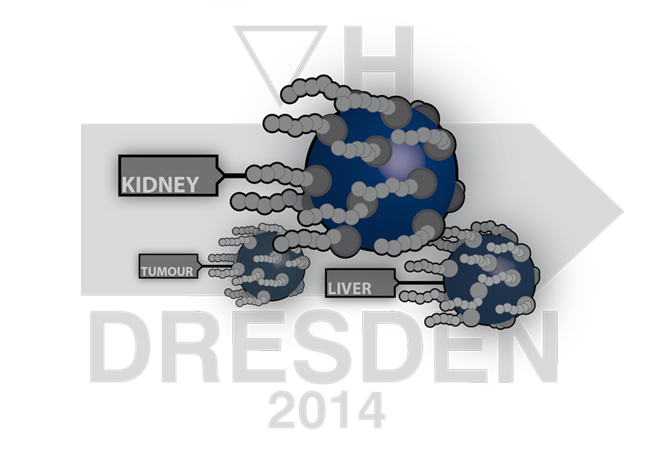
Approximately 400 participants will gather in Dresden, Germany, for the 10th International Conference on the Scientific and Clinical Applications of Magnetic Carriers, to be held on June 10, 2014. The conference, hosted by the Faculty of Mechanical Science and Engineering at the Technical University of Dresden, will run for five days and cover a range of topics related to magnetic carrier technology.
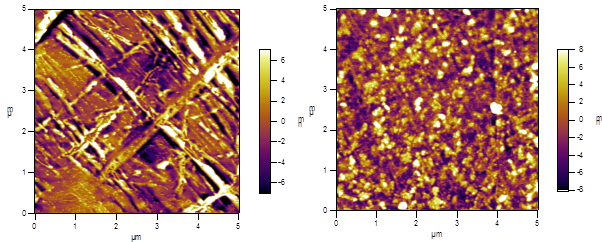
Nanoparticles incorporating different functions are useful and necessary products for assays, drug delivery, and other life science applications. For example, magnetic nanoparticles can be used as contrast agents for magnetic resonance imaging (MRI), to dissipate energy under an oscillating field to locally raise temperature (hyperthermia), or to improve manufacturing of complex nanoparticles via use of magnetic separation. One or more different antibodies and/or fluorescence, luminescence agents as well as other functionalities such as catalytic or enzymatic groups can be attached to nanoparticles.
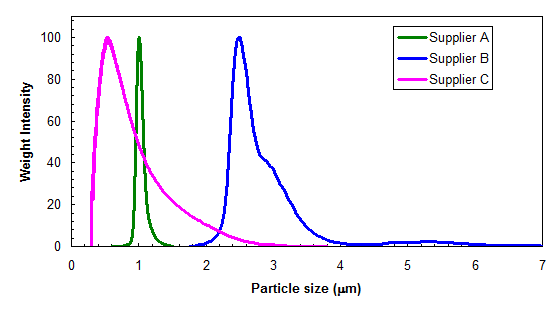
In order to ensure the success of a protocol, it is essential to have a clear and unbiased knowledge base and a reliable source of reference material. When trying to decide the best platform or application to use for a process, it is critical to ensure that the information on which the decision will be based is generic and factual, and not propagated as promotional data.
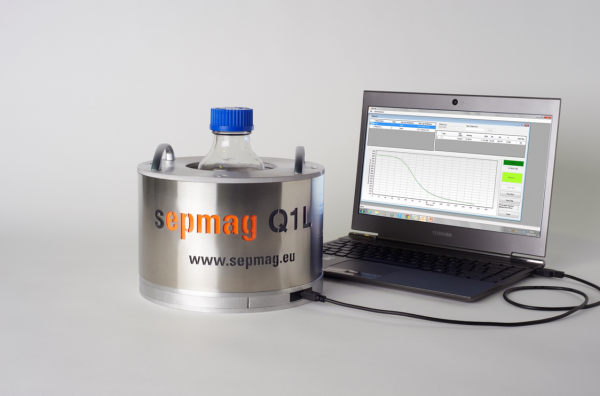
The key issue when transferring a bead coating process from the Research and Development department to the manufacturing department is scalability. It is essential to ensure that the system being utilized for a particular protocol is adaptable to larger volumes. Ideally, any scale-up would be carried out with the use of a homogeneous biomagnetic separator, as this would ensure that the conditions of the protocol are well-defined and able to be reproduced for a larger volume.
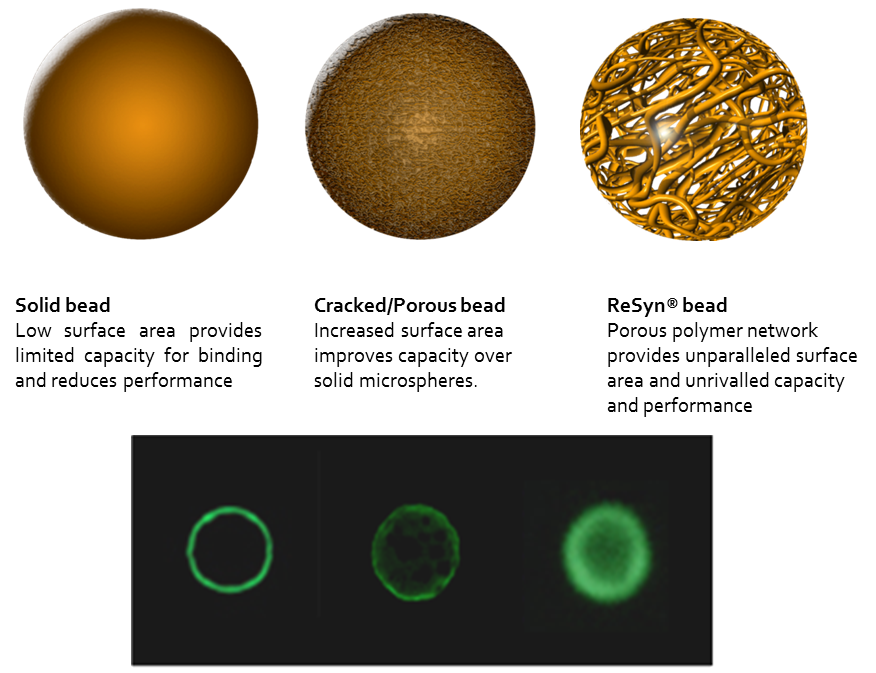
Magnetic beads have several advantages over alternate non-magnetic bead technologies, and are thus finding increasing application in all areas of life-sciences research and development including drug discovery, biomedicine, bioassay development, diagnostics, genomics and proteomics.

It is well known that most recombinant protein purifications are mainly done through different types of chromatography, explained in our protein purification handbook. However, the use of magnetic particles is a very interesting alternative to these techniques, providing great advantages and simplifying the process in many aspects. The necessary equipment for purification with magnetic particles is simple: we need a magnet or any device capable of creating a magnetic field, and the particles themselves.

Next week, 18,000 scientists and other cancer professionals from around the world are projected to move to 2014 AACR Annual Meeting, in San Diego. Attendees are laboratory scientists and clinical investigators specializing in all aspects of cancer research, including experimental therapeutics, molecular targeted therapies, chemistry, molecular biology and genetics, immunology and immunotherapy, tumor biology, virology, toxicology, prevention, and clinical and translational research.
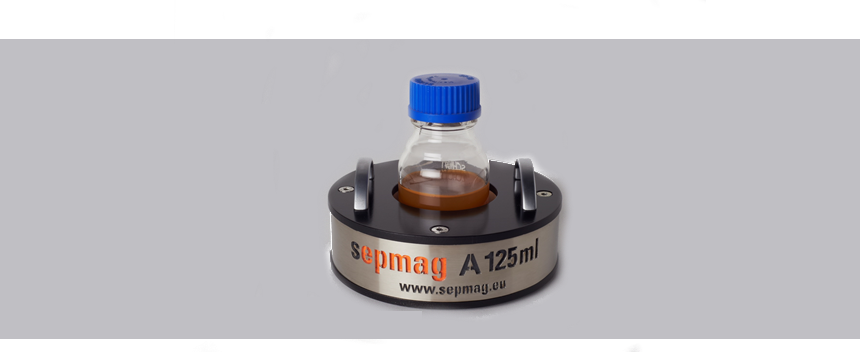
Once a protocol for coating beads is developed and put in place, it will need to be scaled up in order to meet demand. Scaling up a process, however, requires careful attention to ensure that the details of the protocol are replicated for larger volumes.

As you will find in our protein purification handbook, choosing the right matrix for protein enrichment and purification processes, such as immunoprecipitation or pull-down assays, is an important step in optimizing the efficiency of a protocol. The decision will be based on a number of variables and ultimately depends largely on the nature of the target biomolecule. The goal is to choose a matrix that will not only maximize the final yield, but will also be practical and accessible.
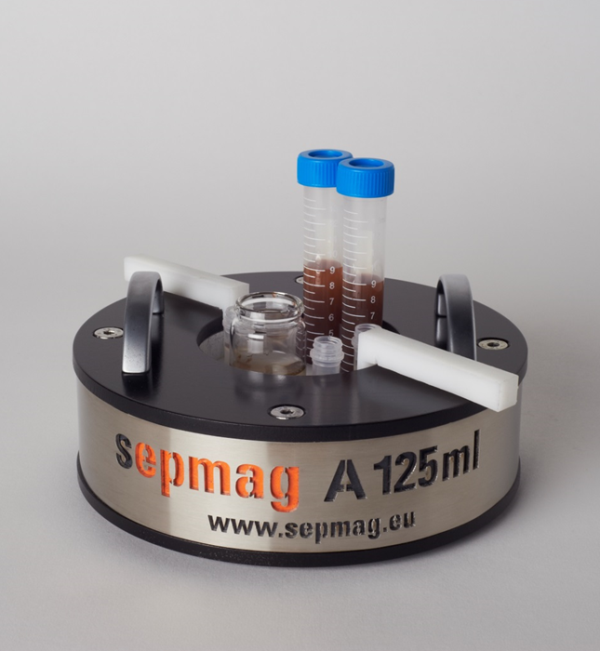
It is well known that most purification processes of recombinant proteins are conducted through chromatographies of different types, mainly in column chromatography. Whether it’s by affinity chromatography, gel filtration or ion exchange chromatography, these already established methods are not exempt from limitations. Research in recent years has allowed us to develop a series of alternatives to chromatography that allow us to avoid many of these limitations.
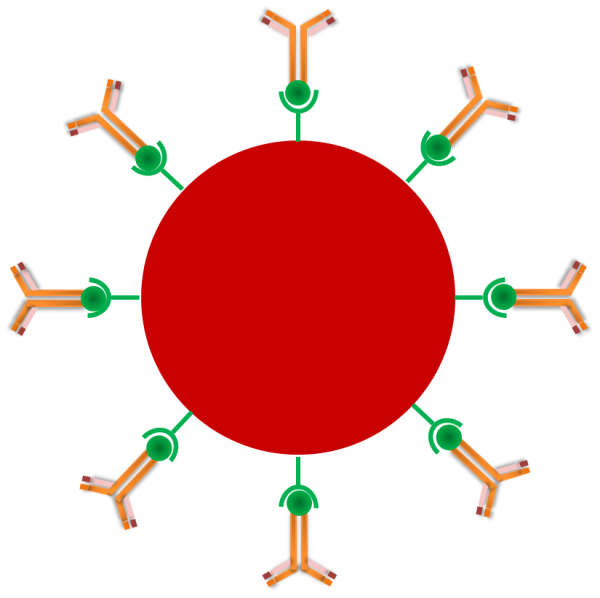
This is the last of a series of posts on pros and cons of classical covalent links, which we have been publishing during the last few weeks. This one is about 3 well-known classical covalent links: streptavidin beads, biotin, protein A and protein G.

Merck Millipore has invited experts from around the globe to attend the symposium it has organised at the Hilton Hotel in Shanghai on May 15 and 16. The event will include contributors from China, as well as Germany, New Zealand, Russia, Spain and USA.
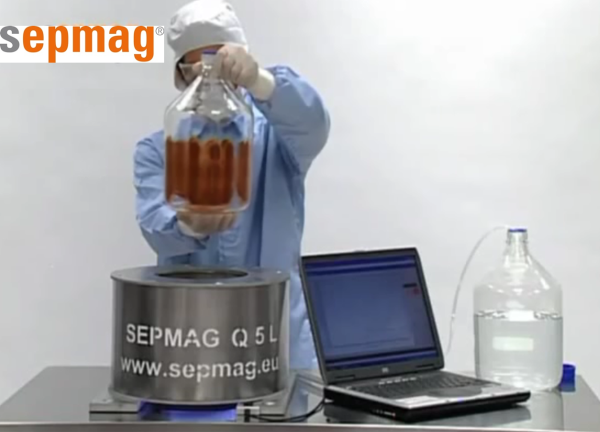
In purification of recombinant proteins, highly pure samples are rarely obtained with the initial stages of the process. Whether we perform a highly specific affinity chromatography (with histidine tags, for example) or purification with several stages of capture and intermediate purification, there are always contaminants in the final sample. As you will find in our protein purification handbook, these contaminants are molecules that are closely related to the protein to be purified since, if a high-resolution technique is not applied, they can be hardly differentiated from the protein to be purified.

This is the second of a series of posts on pros and cons of classical covalent links, which we will publish during the next few weeks. This one is about 3 well-known classical covalent links: tosyl, epoxy and chloromethyl groups. In the next posts we are going to review other examples, such biotin or streptavidin beads.
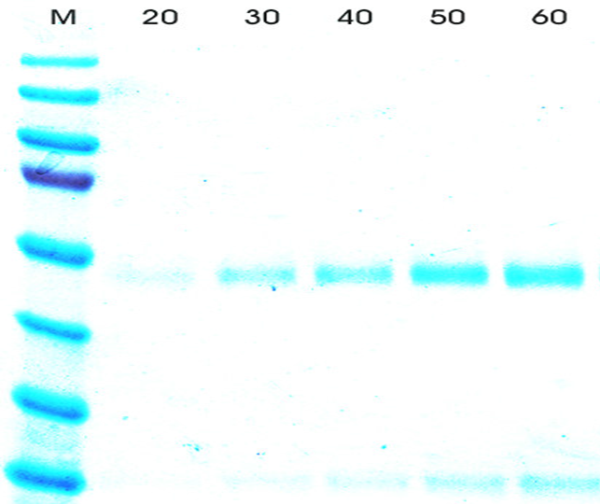
Affinity chromatography allows us to obtain good results and a high level of purity with a single purification step, since a structure that is exclusively found in the recombinant protein is used as a tag. However, this is not possible in all cases. There are proteins that don’t accept changes in their sequence, even if the changes are so minimal as the incorporation of a tag, since the proteins quickly lose their biological activity with any modifications in their structure.
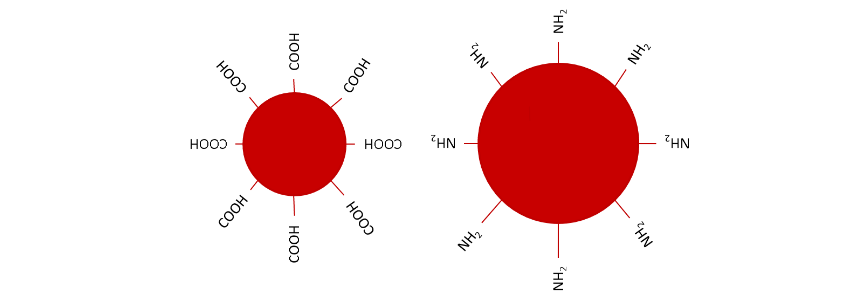
This is the first of a series of posts on pros and cons of classical covalent links, which we will publish during the next few weeks. The very first one is about 3 well-known classical covalent links: carboxyl, hydroxyl and amino groups. In the next posts we are going to review other examples, such as tosyl or streptavidin beads.
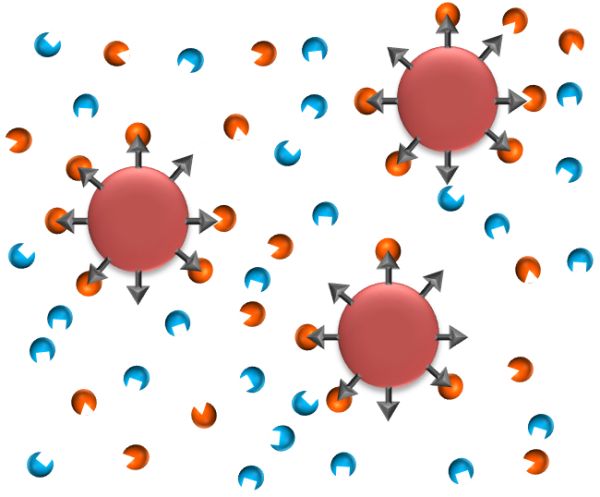
The purification of recombinant proteins is a long and complex process, as our protein purification handbook proves, and is influenced by a multitude of variables. As has already been mentioned, the nature of the protein itself, its properties and the characteristics of the host producer will greatly influence the design and development of this procedure. There are also very few available techniques, although it is very well known that the preferred one is affinity chromatography.
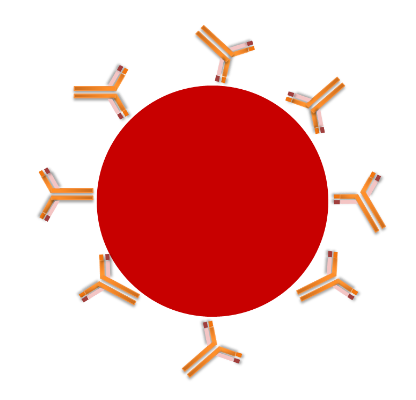
Attaching a protein to a bead can be a detailed process that requires forethought and careful planning. Generally, a molecule is attached to a particle through a surface group available on the coating of that particle, for example in the case of streptavidin beads. In cases where the attachment is covalent, it is essential to choose a binding site on the molecule that will allow for proper orientation, maximally presenting the desired site to the sample while still retaining a strong attachment between the molecule and the bead.

During the sample preparation for the purification of recombinant proteins, there are several considerations that will influence its development. All preparation steps, which are thoroughly explained in our protein purification handbook, are important and we have to pay attention to them.
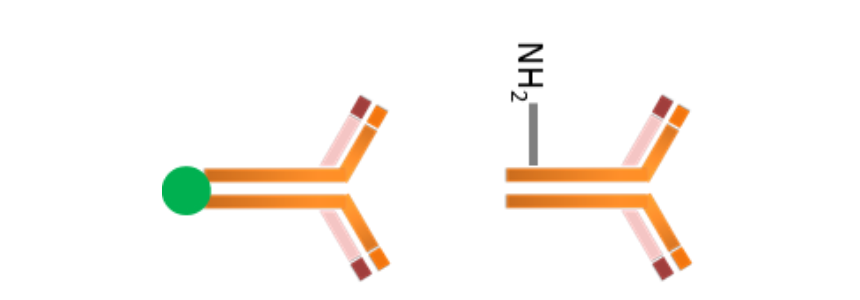
Preparing magnetic beads for a particular assay, such as streptavidin beads, requires the beads to be functionalized. The beads need to be attached to the biological material that will serve as a capture molecule in the application. The particular type of attachment by which a molecule is linked to the bead will depend primarily on two things: the molecule being bound and the aim of the process.

Should I use streptavidin beads or gold particles when developing my IVD kits? In order to ensure the success of a protocol, it is essential to have a clear and unbiased knowledge base and a reliable source of reference material. When trying to decide the best platform or application to use for a process, it is critical to ensure that the information on which the decision will be based is generic and factual, and not propagated as promotional data.
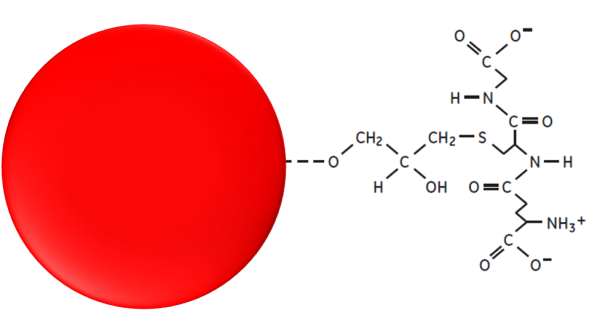
Chromatography is one of the most common methods for the purification of recombinant proteins, and more specifically affinity chromatography is the one that is mostly used due to its high specificity, which allows us to obtain great purity in one single step. When using this technique, a tag is added to the protein of interest, a small structure that is not included in the original protein and that allows us to easily capture it. As we explain in our protein purification handbook, tags are generally short sequences of 3-4 amino acids (up to a maximum of 15) and are intended to minimize as much as possible the properties of the protein.
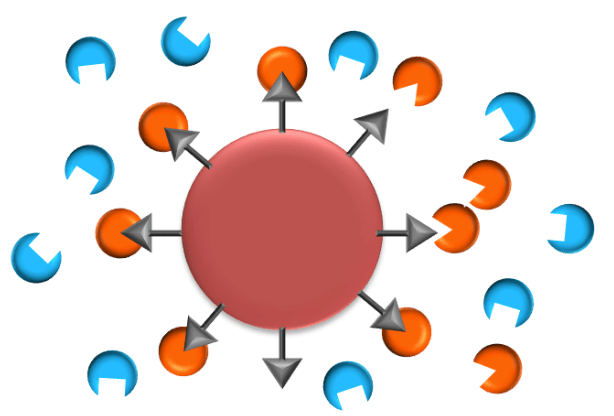
Recombinant proteins are produced in the host cells along with a great variety of molecules that it contains naturally. However, for most of their applications (such as for example in therapeutics), a recombinant protein should be purified and isolated from the rest of cell molecules. As we explain in our protein purification handbook, this is obtained by the recombinant protein purification processes.
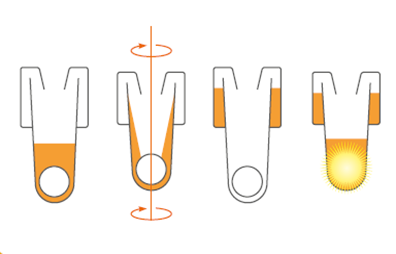
There are a number of reasons why a lab might want to switch from colloidal gold particles to magnetic beads (for example, streptavidin beads) in an in vitro diagnostic assay, such as swapping from optical to magnetic detection in a lateral flow format or charging the format from lateral flor to a lab automated platform. Making the shift from utilizing one nanoparticle to another, however, is not a straightforward process. There are several areas where problems may arise. There is a considerable difference, for instance, in the way gold particles and magnetic beads bind a molecule. Moreover, the methodology for applications utilizing gold particles is significantly different from that of processes that make use of magnetic beads.
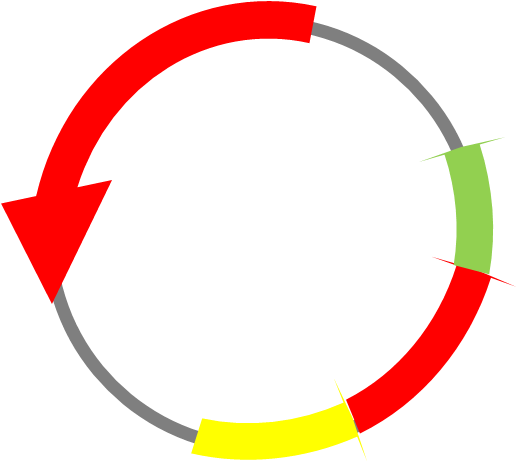
The host in which a recombinant protein is produced doesn’t naturally include the gene of this protein in its genome. Therefore, this gene needs to be introduced in a process called molecular cloning. Successful cloning of a gene requires several elements, which are discussed in our protein purification handbook.
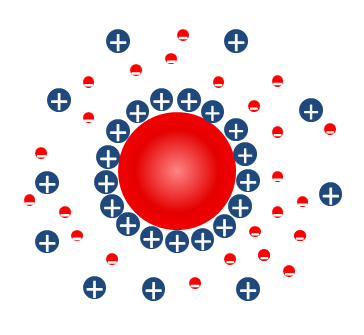
In vitro diagnostic (IVD) applications frequently make use of nanoparticles as solid-phase carriers for a given capture molecule. In order to be utilized in this manner, nanoparticles must first be coated, thereby attaching the capture molecules to the particles. There are notable differences in the way that different types of particles are coated, and this will be a significant factor in the decision to utilize one particle over another in a given assay, for example, streptavidin beads or latex particles.
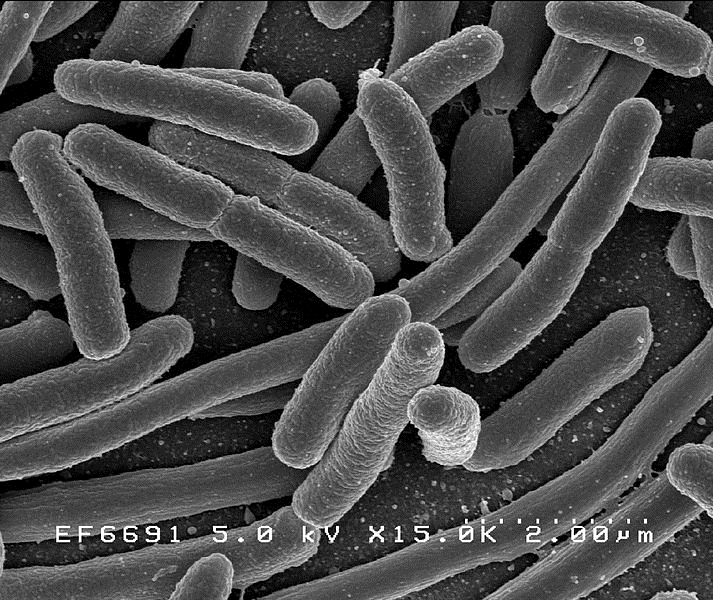
As you can learn in our protein purification handbook, production techniques of recombinant proteins offer multiple options when it comes to available hosts; in other words, the organisms that incorporate the gene of the protein of interest and express it correctly.
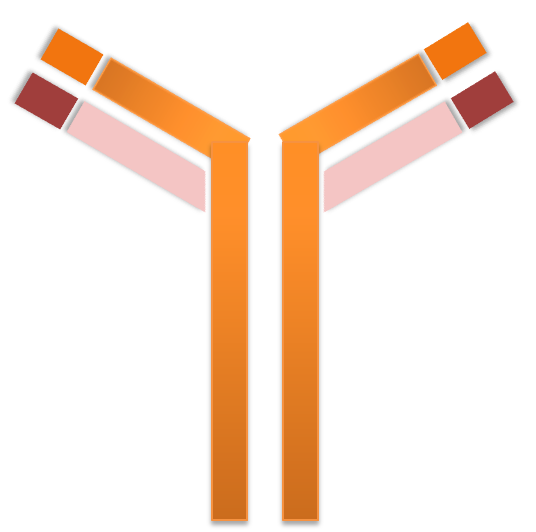
Because of their significantly increased surface area and their ease of manipulation, in vitro diagnostic (IVD) assays commonly make use of nanoparticles, typically utilizing them as solid surface carriers for capture molecules. There are a number of particles that can be utilized in IVD assays. White latex particles, for instance, have traditionally been used in diagnostic tests such as immunoturbidimetry and nephelometry assays, but we find other interesting examples such as streptavidin beads.
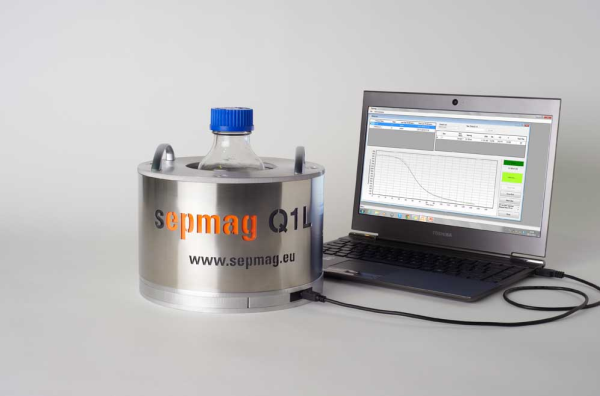
The traditional way to check whether a biomagnetic separation process is complete is by sight. The technician/researcher looks at the suspension: at the beginning of the process, the suspension is homogenous and opaque, but when the separation process is complete, the magnetic beads are left on the walls of the vessel and the supernatant is transparent. When the suspension is ‘transparent’, the technician stops the process by extracting the supernatant, leaving the magnetic beads in the bottle.

As you will learn in our protein purification handbook, proteins are biomolecules of great value to humans, since they have a wide variety of uses in different sectors. They can have therapeutic (such as in insulin cases or blood clotting factors), industrial (such as the lipases that are included in detergents that degrade grease stains) or biotechnological (in the case of certain toxins that are used as pesticides) applications. They also have an extensive application in the research field, in cases when they can be used to study the molecular mechanisms of many diseases, find new drugs, or elucidate tridimensional structures, among others.
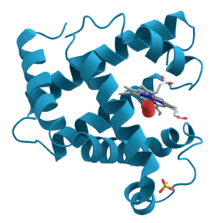
Human beings extensively use proteins for different purposes such as health, industrial production or food. Nevertheless, most of these proteins come from natural sources that do not produce them in sufficient quantities for human use; therefore, we turn to the use of recombinant proteins. Such proteins are obtained from organisms (called “host organisms”) that do not produce them naturally, and in which the gene of the protein of interest is incorporated.

Sometimes during biomagnetic separation in a magnetic separation rack, different steps in the process require using different volumes. For example, if you have produced a ‘mother batch’ of magnetic beads and this large batch needs to be aliquoted so that each aliquot of beads can be uniquely coated, you will need the ability to move easily between volumes.

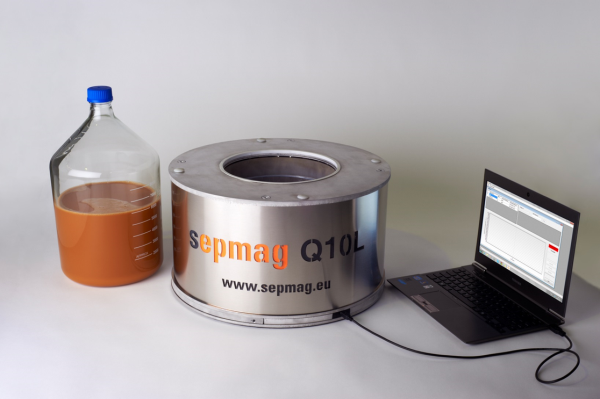
Although separation time may be one of the most obvious parameters to validate in your magnetic separation rack production, it is certainly not the most critical. Classical magnetic separation rack use non-homogeneous magnetic separation. When scaling up production on these devices, larger volumes can lead to longer and longer separation times.

Any small magnetic separation rack (i.e. the types used to develop a prototype product before scaling up) generates magnetic fields that decay rapidly with distance. However, scaling up the process can be problematic because the size of the classical magnetic separation rack itself grows rapidly with desired batch volume. Because the magnetic field profile and the magnetic force are not the same in a larger device, the safety of users and the safety of ancillary equipment can become a serious issue.
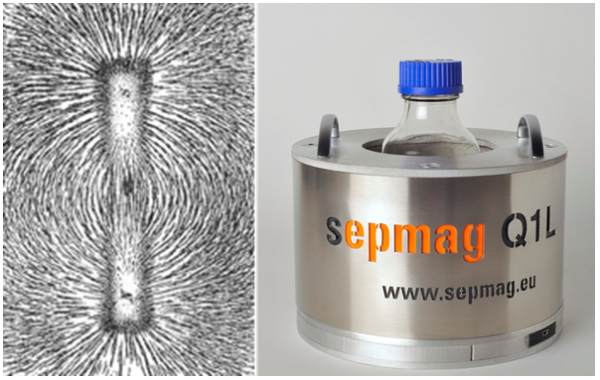
Electromagnets are the classical way to generate intense magnetic fields. If you apply the electrical current across a coil, the magnetic field is quite small. But if you wrap the coils around an iron yoke, you can generate much stronger magnetic fields. Unfortunately, if you need to scale up a magnetic separation process, you also need to increase the electrical power to the magnetic separation rack and the amount of iron and copper used for the coil.

Magnetic bead kits are widely used in bioscience laboratories nowadays, as their development and perfecting during recent years has been significant. Both scientists in research labs, for immunoassays and magnetic separation processes, and lab technicians in hospitals, using IVD kits for molecular diagnostics, have experienced an improvement in their separation processes due to these magnetic bead kits. As using a biomagnetic separation process has proven useful for these applications, the increasing demand in magnetic beads has lead providers to develop cost-effective ways for their production.


A very common problem that occurs when scaling up non-homogeneous magnetic separation processes in a magnetic separation rack is irreversible aggregation of the magnetic beads. When the process is scaled up, the magnetic force experienced by the beads closest to the magnet is very high.

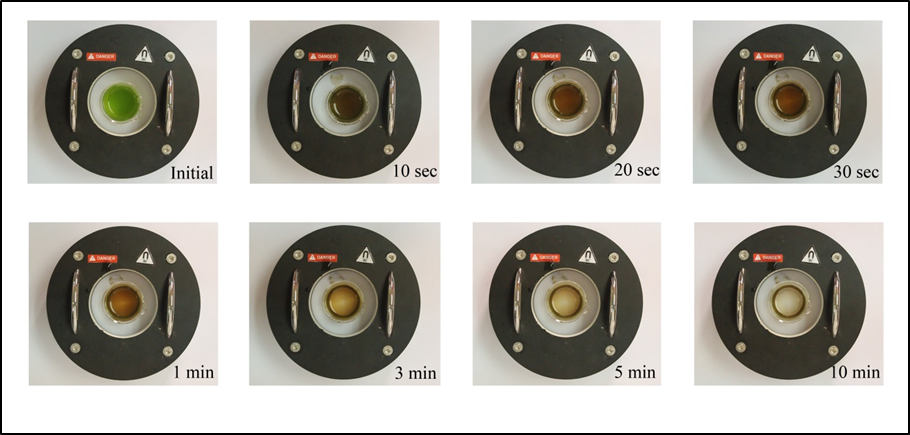
Microalgae become the exclusive focus in research of biofuel production to meet global energy demand. Photosynthetic microalgae use the sunlight to form biomass from the supplement of carbon dioxide and water. One of the main constituents of microalgal biomass is the natural oil stored within the cells. This natural oil can be further transformed into biodiesel through a transesterification process. The biofuel is renewable with huge potential to replace the fossil fuel. The International Energy Agency has reported that the total final oil consumption of the world in 2010 has reached 3575 Mtoe.1
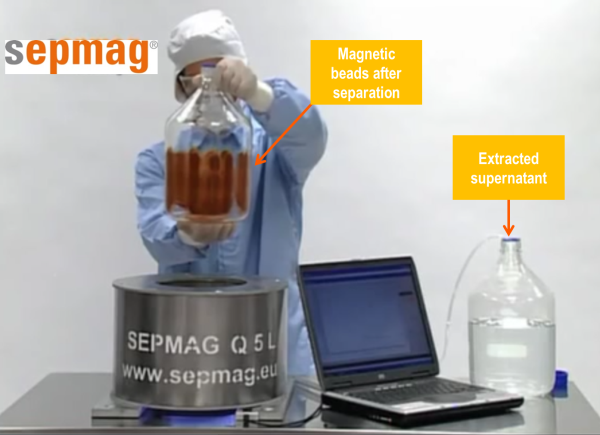
When using a standard magnetic separation rack, often you will experience a decrease in bead and biomolecule yield when scaling up your production process. This causes the scaled up process to be less economically efficient than it could be with yields commensurate to your original production.


Classic magnetic separation rack devices are designed such that both the magnetic field gradient and the magnetic state of the beads vary with the position of the beads. This means that once a process has been validated at a specific volume (i.e. your process has low material losses and no irreversible aggregation), it is difficult to change batch size without needing to re-validate the process.


Chemiluminescent Immunoassays (CLIAs) are excellent assays for high throughput, low analyte concentration, time sensitive testing and isolation. Using magnetic beads as the reagent in a CLIA, for example coated in the form of streptavidin beads, is an easy and established technique favored among many clinical scientists.
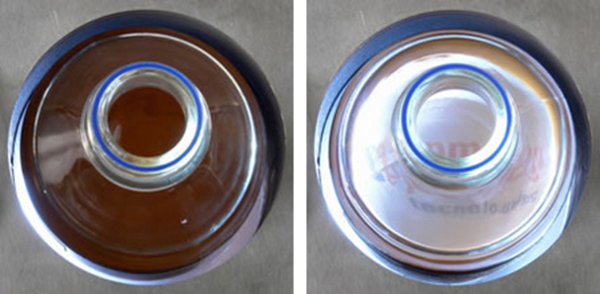
Any small volume classic magnetic separation rack is relatively cheap and does a fairly good job at separating magnetic beads. However, if the process involves multiple instances of capture and elution steps, irreversible aggregation becomes a real problem. In small volume separations (i.e. on the order of milliliters), using the appropriate techniques can give you excellent re-suspension results.
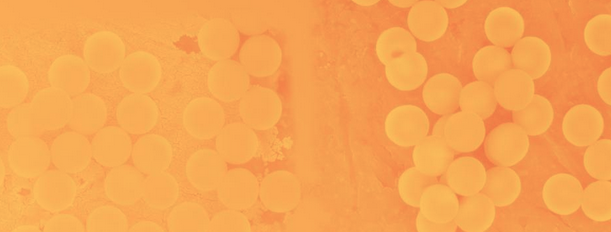
Magnetic bead suppliers vary in how they produce their product, how they deliver their product and how they guarantee their product. Some suppliers will also only provide common types of magnetic beads, such as magnetic streptavidin beads, while others will offer more specific products.
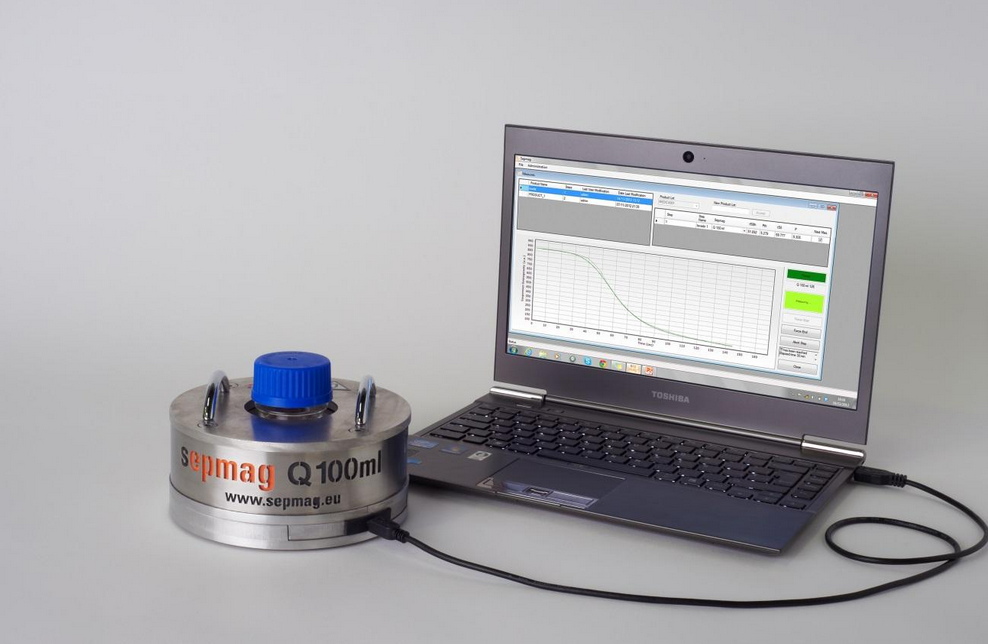
When new magnetic beads reach the market, one of the questions users have is, how well will it separate?

In a standard magnetic separation rack, scaling up to a larger lot volume usually creates four common problems:


The most frequent concern when considering the use of modern Biomagnetic Separation Systems is their compatibility with specific magnetic beads. Although Sepmag® devices are already working successfully in IVD labs and production lines, this is a very legitimate question.
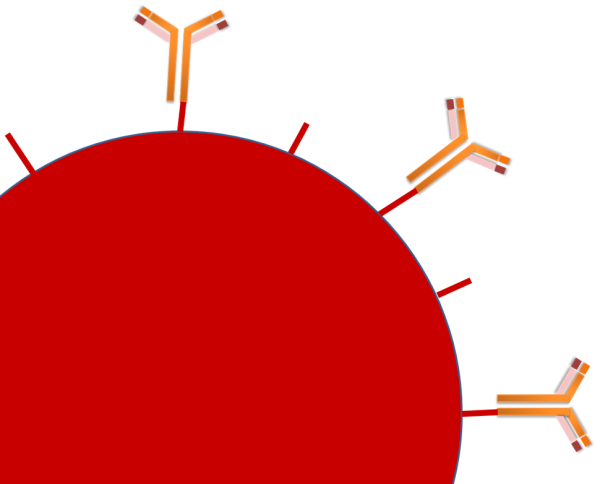
Non-specific background and auto-aggregation in chemiluminescent immunoassays are often caused by the presence of exposed hydrophobic surfaces on the magnetic beads. The use of a blocking reagents combined with gentle homogenous bio-magnetic separation will help reduce background and auto-aggregation of your coated beads.

It is vitally important to understand the process and all of the variables of the process when scaling up a biomagnetic separation in a magnetic separation rack. If you do not understand the details of your process, you will throw away your initial investment you made in validating your initial process and jeopardize the product’s time to market.
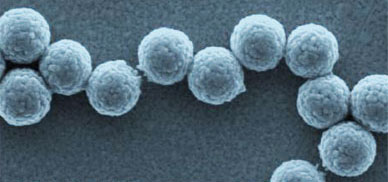
Stability of magnetic bead IVD kits over time is important and should reflect the environment that is typically encountered by their reagents. For example, if the reagents will be frozen and thawed, stability should be addressed in these conditions. Magnetic beads, such as streptavidin beads, may behave heterogeneusly in different conditions, so these should be preserved when performing stability studies.
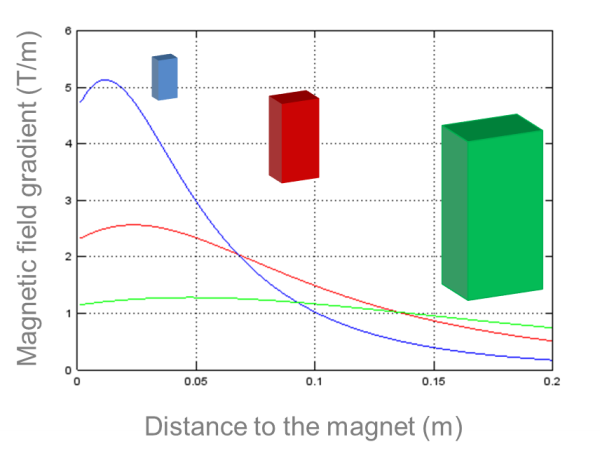
The most common mistake when attempting to scale up production of magnetic beads using a classical magnetic separation rack is to use the same magnetic field that was used at smaller volumes. But keeping the magnetic field constant at different volumes will not give you the same results because the separation conditions are completely different.
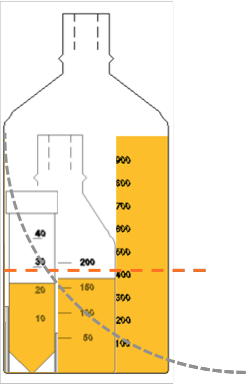
Sometimes companies scale up production in a magnetic separation rack in order to produce large quantities. However, for validation batches or new processes, they may not need to work at the large scale level. In addition, different steps of the process may require different volumes. For example, if you are producing a large ‘mother batch’ of magnetic beads, different portions of that ‘mother lot’ may be used for unique coatings. Another example is when small validation lots of a product need to be produced before launching full scale production of the product.

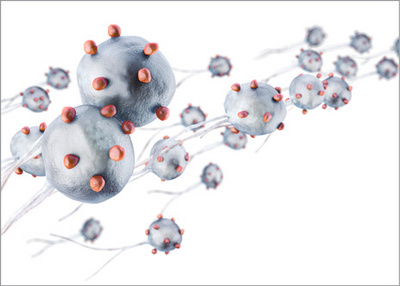
As we have explained in previous posts, magnetic beads can aggregate due to different reasons, bringing problems to the processes they are used for. If you want to learn more about breaking up irreversible magnetic bead aggregates, with techniques such as the sonication method, keep reading!
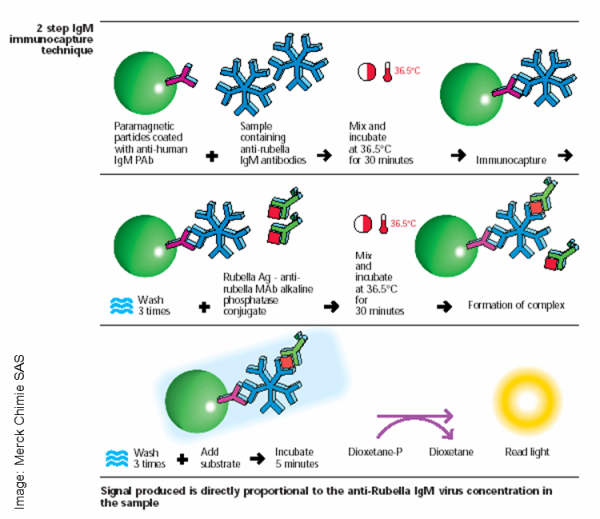
Although there are many choices you can make when determining bead surfaces, there are five predominant types of magnetic beads currently used most often by Chemiluminescent Immunoassay (CLIA) companies.
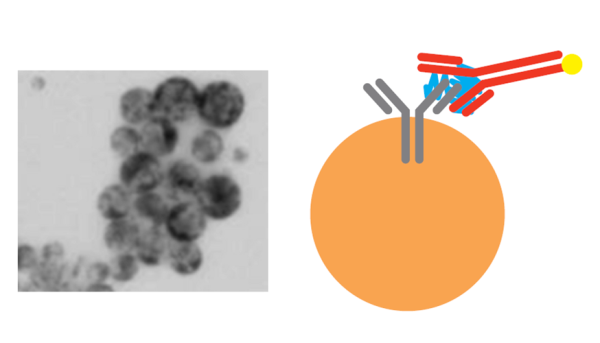
Chemiluminescent immunoassays (CLIAs) are excellent assays for high-throughput, low analyte concentration and time sensitive testing and isolation. Using coated magnetic beads, such as streptavidin beads, as the reagent in a CLIA is an easy and established technique favored among many clinical scientists.
The main consumers of magnetic beads are In Vitro Diagnostic (IVD) companies who utilize these materials for their kits. Since some of these companies are highly successful, as they obviously need to cope with higher demand for their kits by increasing production in a magnetic separation rack.
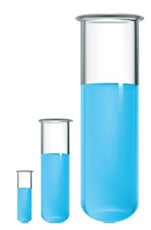
When you decide to scale up your process, one of the most difficult parameters to determine in a non-homogeneous magnetic separation rack is the separation time. In scaled-up non-homogeneous devices, you must use longer separation times in order to gain the same bead yield as a smaller process. However, it is still difficult to determine when the separation is complete.

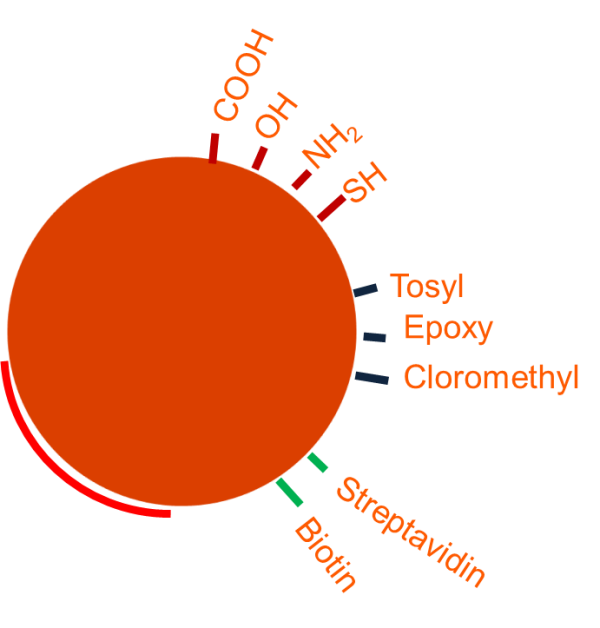
Depending on your antibody and your assay, you have a number of ways to couple your protein or antibody to the surface of your magnetic beads. Once again, forethought is important in choosing which bead surface to use. Plain surfaces, modified surfaces or pre-activated surfaces in streptavidin beads are examples of these possible choices.

When you have systems that have large standard open magnets that can generate stray fields, such as a non-homogeneous magnetic separation rack, the devices can be very dangerous. The magnetic fields generated all around the device and are known to have caused laboratory accidents in the past. Scaling up a process means that the stray fields will increase quickly with the size of the device.

When determining which magnetic microsphere to use for your CLIA, it is important to take into consideration a variety of different variables. Magnetic streptavidin beads are a well-known example of these magnetic microspheres, but there are many alternatives we must take into account.
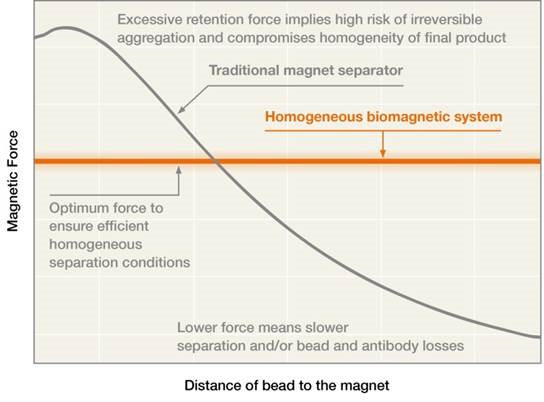
Working with a magnetic separation rack, at small volumes it is easy to create and use a quadripol electromagnet to generate high forces during biomagnetic separation processes, even to the point of making the process very close to homogeneous. The main advantage to using electromagnets for this type of process is the ability to easily modify the current passing through the magnetic coils, thus modifying the value of the magnetic field and force during the setup of your process.

In Chemiluminescent immunoassays, antibodies are bound to the used magnetic beads (such as streptavidin beads) in order to detect a certain analyte. However, there are different types of antibodies that behave in different ways and recognize a variety of epitopes.

On 10, 11 and 12 of October, the Japanese Association of Clinical Laboratory Systems will hold its EXPO2013 at the Pacifico Yokohama Convention Center.

When companies desire to increase the volume and scale up their production using a non-homogeneous magnetic separation rack, they use higher magnetic forces in order to separate the biomagnetic beads. As a result, the forces experienced by the beads nearest the magnet are extremely high. In addition, the time of separation also needs to be increased substantially when the volume is increased in order to collect an acceptable percentage of beads in a non-homogeneous system.

When developing and using a CLIA, it is important to follow eight basic steps in order to ensure that your assay will be the most efficient and accurate that it can be. Whether we are using magnetic streptavidin beads or another type of beads, these are the steps we must follow.
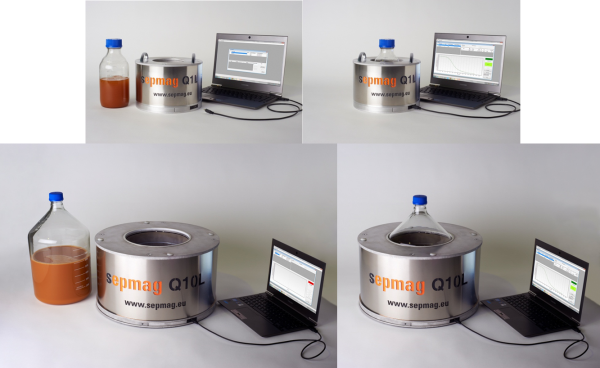
During non-homogeneous separation in a magnetic separation rack, in order to generate a magnetic force, you need to use magnet arrangements to create a variation in the magnetic field. In this situation, the magnetic force will always vary with distance from the magnets.

When a non-homogenous magnetic separation rack (a classical system) is used for scaling up a process, the conditions for a larger batch will completely change from the smaller batch. In these classical non-homogeneous magnetic separator, both the magnetic field gradient and the magnetic state of the beads (either linear or saturated) will vary depending on their position and relative distance to the magnet.

Well-established classical detection methods that are packed in kit form include Radioimmunoassays (RIAs) or Enzyme Linked Immunoassays (ELISAs). These two detection methods were highly sensitive and used for a variety of biological and chemical testing. Even though RIAs are very sensitive assays, by their very nature, they are comprised of highly hazardous, radioactive reagents. The handling and disposal of RIA refuse can be difficult to regulate in the lab environment as well as expensive.
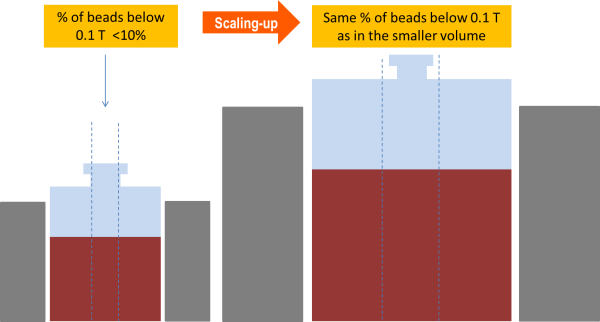
While it might be thought that ‘bigger is better’ during a scale-up process, merely using a larger magnet in a magnetic separation rack for larger volumes generates very different conditions. This leads to inconsistencies and other problems with the final product.
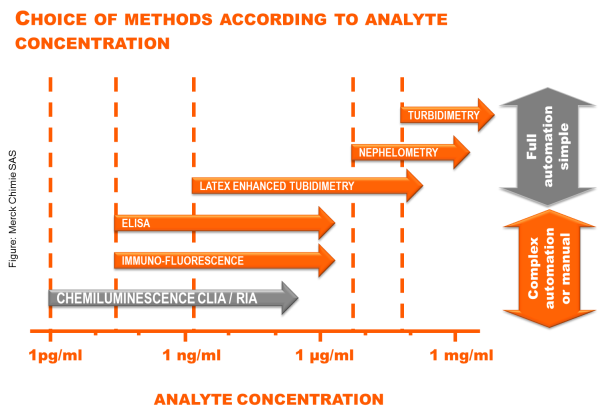
Retrieving analytes from their original sources (especially when working on proteins) can be tricky and difficult. In addition, various methods of analyte recovery are highly concentration dependent. For example, analytes can be extracted from very concentrated samples, e.g. greater than or equal to 1 mg/ml, with methods such as nephelometry or turbidmetry. Lower concentrations such as 1 ug/ml require the use of an ELISA or Immunofluorescence assays to isolate the desired analyte.

Working with magnetic separation rack? Keep reading!

Irreversible aggregation is one of the main concerns when functionalizing magnetic beads for use in diagnostic and biotech applications. The presence of aggregates can cause high variability in the functionality of the magnetic beads and large inconsistencies. Irreversible aggregation causes serious problems when one tries to resuspend the particles after the processing, coupling and washing steps. Because of this, as we have explained in previous posts, one of the best ways to solve this issue is using the sonication method.
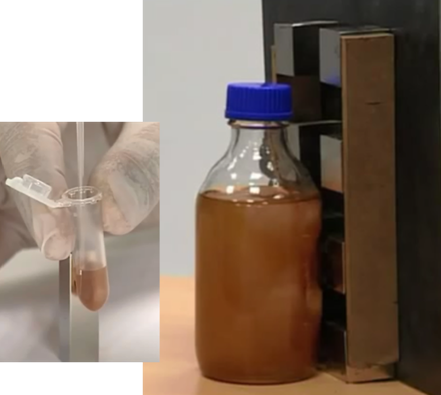
Do you want to learn how to take the most of your magnetic separation rack? There are lots of common mistakes related to the scale-up of biomagnetic separation processes, and lots of them imply the use of non-homogeneous magnetic racks.


When biomagnetic particle kits are initially developed, R&D companies work with small volumes in a magnetic separation rack in order to test and optimize a number of variables. When the kit is deemed successful, the company obviously wants to take the kit to market and consequently ramp up production.

Today we'll learn more about breaking up irreversible magnetic bead aggregates with different methods such as the sonication method, are you ready?
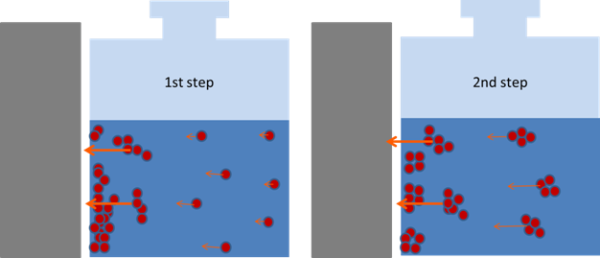
End product variability is caused in large part by resuspension problems in your process. During a magnetic separation process, the retention forces in the system need to be high enough that losses of the beads will be avoided when the buffer is pumped out. But the forces should not be too great because if they are excessive, beads will aggregate.

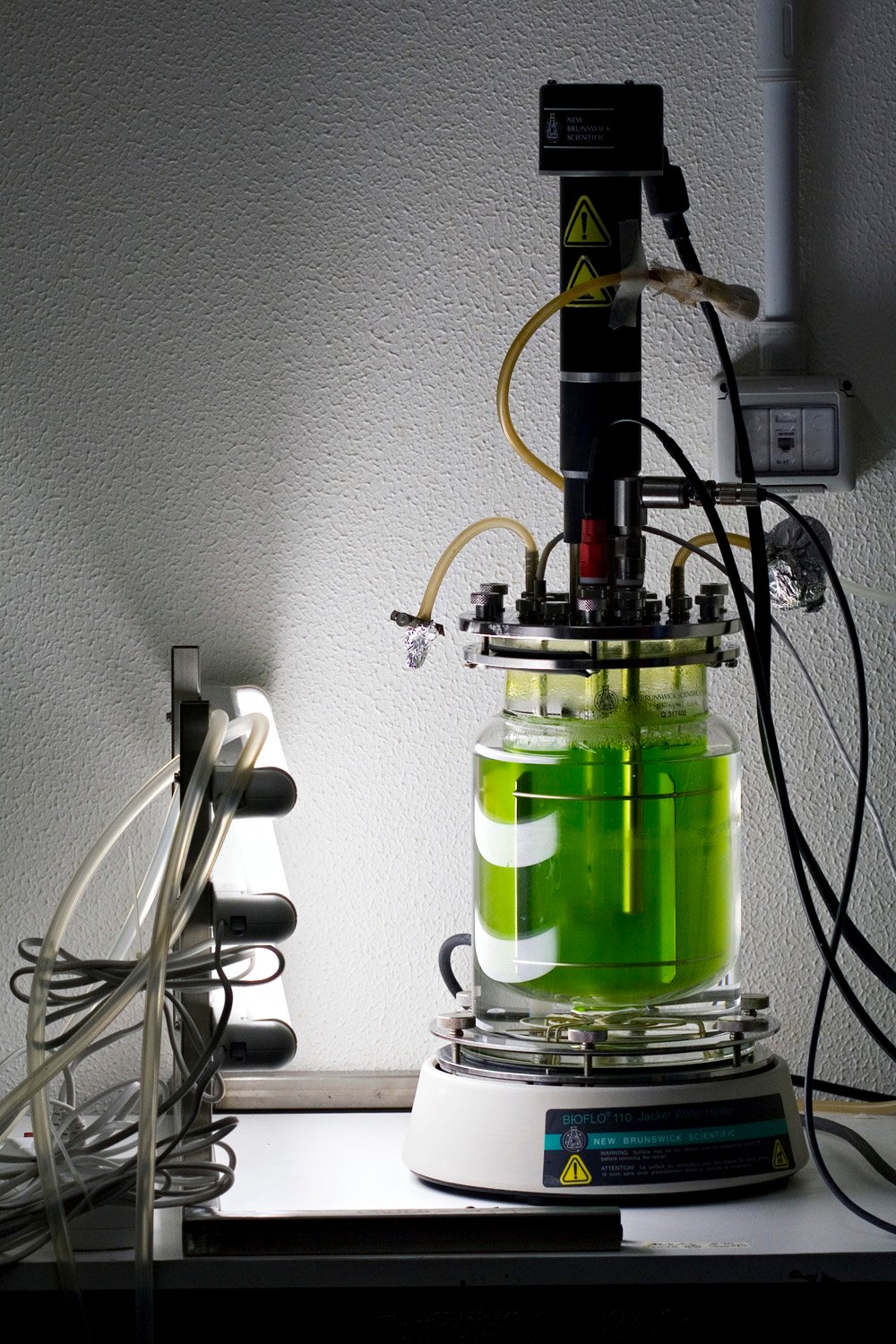
Bioreactors are an advanced phase of any production process, as small scale production has been left behind and scale up is being developed. Increasing the working and production volume brings many benefits to the process, but it is also more difficult to work with larger volumes, including when we work with magnetic beads.
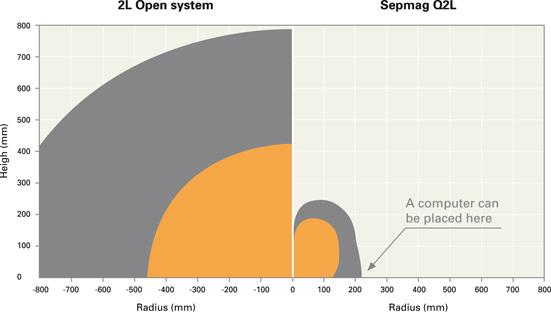
Large magnetic systems create potentially high risk environments in terms of safety during a magnetic separation process. These systems generate large magnetic fields which result in the generation of large stray fields. The stray fields affect the surrounding environment and can attract ferromagnetic objects, potentially injuring system operators. The larger the system, the higher the risk, especially if workers do not follow Health and Safety protocols.

At the end of the month (July 28-August 1) Houston will host the AACC 2013 Annual Meeting, which includes the Clinical Lab Expo. The organizers claim that Clinical Lab Expo is the largest in the World. I am not in a position to endorse or refute this claim, but even if it is true, it is irrelevant from the perspective of the magnetic beads supply chain.
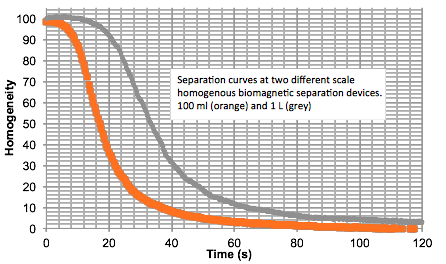
The concentration of magnetic beads is an important step in a magnetic separation process. Separation time is dependent on magnetic bead concentration, and final kit performance is also very dependent on accurate concentrating techniques, but liquid handling inaccuracies can lead to serious errors. If these concentration errors are not detected early in the process, excessive time, money and effort will need to be spent to either correct or redo the batch.
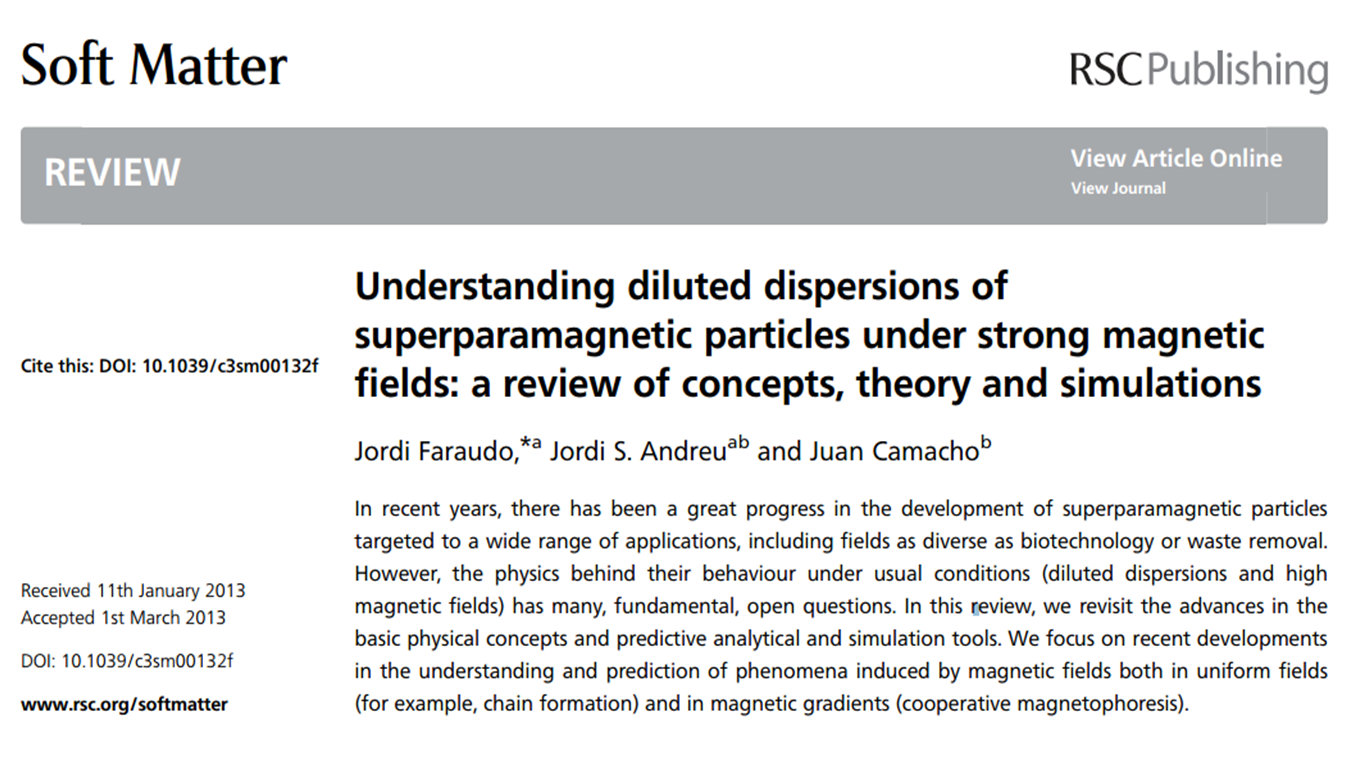
Learning more about the behavior of magnetic beads separation when strong magnetic fields are applied
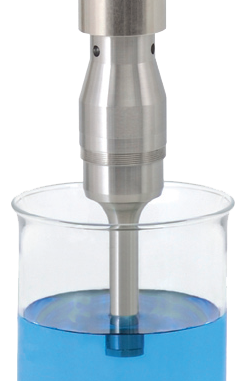
The sonication method is a very effective method for breaking up magnetic bead aggregates, but it is not a panacea. It is an efficient technique once all of the parameters are set, but it is a complex technique with some important limitations, especially for high volume processes.
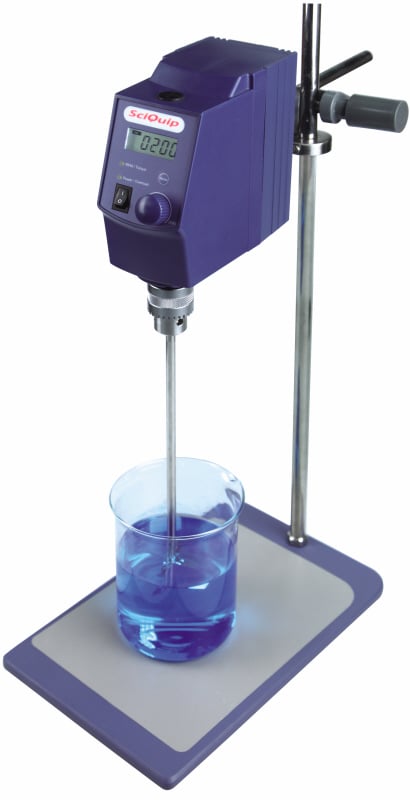
Irreversible aggregation of magnetic beads is a great concern among researchers because of the variability it introduces into the process. Knowing how to deal with these aggregates when they do form, with techniqes like the sonication method, is the best way to increase in-lot consistency.


When one scales up production using a classic magnetic separation system, one finds that the separation time increases quickly with an increase in production volume. An increase in separation time means that material losses are higher and aggregation problems become a serious problem. By using homogenous separation time, one finds that the magnetic separation process is shorter and the separation time can be easily estimated. In homogeneous systems material loss and bead aggregation is minimized.

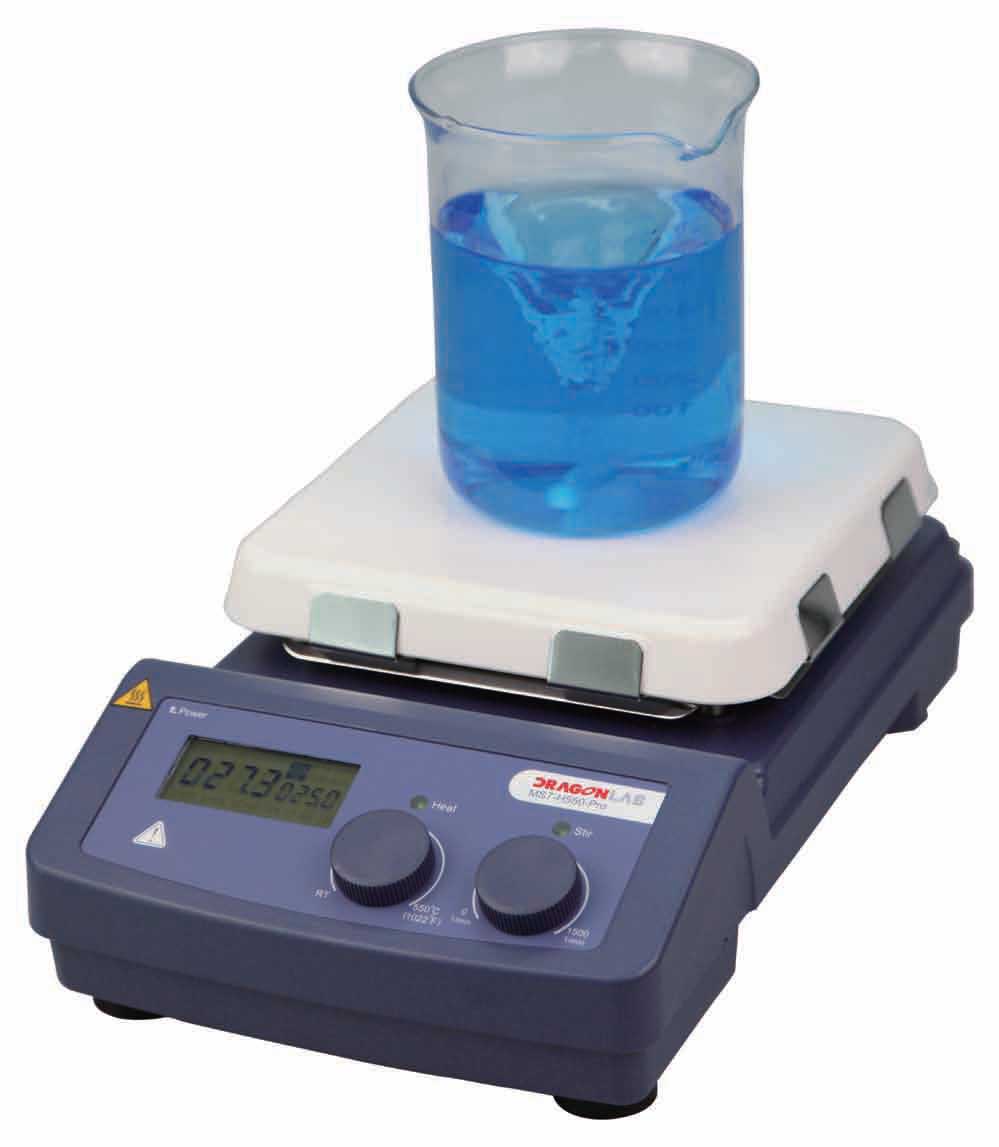
Magnetic beads need to be constantly mixed and homogenized to avoid sedimentation and clumping problems. Even when the sonication method is necessary to break up aggregates, mixing and homogenization is necessary.
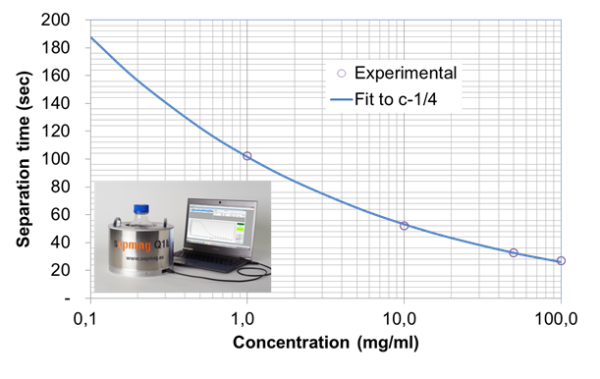
In the Life Sciences, one of the most critical parameters for final IVD kit performance is magnetic bead concentration. The beads are functionalized before the magnetic separation process with antibodies or other biological molecules, so the concentration of magnetic beads also delivers a specific concentration of biologically active reagent. If you do not have the correct amount of beads/biological molecules in your preparation, the sensitivity of the kit changes significantly. Therefore volume control of the suspension is quite important.

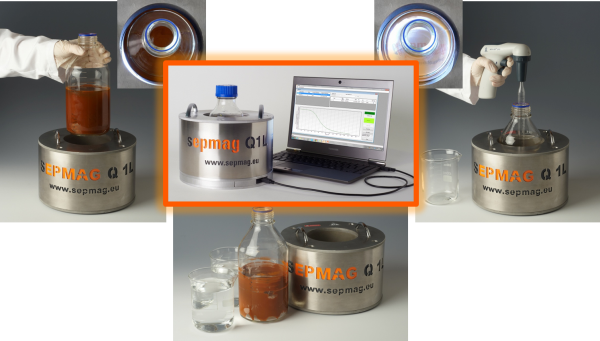
In non-homogenous magnetic separators, monitoring the entire separation process is difficult to impossible. As a result, errors in the magnetic separation process, such as using the wrong magnetic beads or using buffers with the wrong properties are not detected until the final QC testing stage.


The sonication method is used to break up irreversible magnetic bead aggregates when they are generated during various steps of the production process. However, sonicating a large volume is not a straightforward process. To set up a largevolume sonication, you must choose the proper probe, the power, and the conditions, but choosing and determining these things can be tricky.
This post is about resuspension techniques, such as the sonication method, and how they can solve magnetic bead aggregation. If you are interested in this topic, download our free ebook The basic guide for resuspending magnetic beads:
One very important thing you must ask yourself is ‘why do I have aggregates in the first place?’. There are two possible causes of irreversible aggregation that you need to investigate:
1. Did you properly block the exposed hydrophilic bead surface after coating?
During the production process, you will coat the beads, but you will not always be able to coat their entire surface. If you have not blocked the parts of the beads not covered by your antibodies or antigen, these exposed surfaces can react with other proteins or with the protein on neighboring beads. If you are using the correct blocking reagent, you will reduce auto-aggregation, thereby reducing non-specific background reactions.
Since avoiding aggregate formation altogether greatly simplifies re-suspension, it is worth trying different blocking reagents to find the optimal re-suspension conditions (e.g. BSA, Tween 20, Triton-X 100, etc.).
2. Are you applying excessive magnetic force when separating the beads?
The magnetic force in classical separation systems decreases quickly with distance from the magnets. Because of this, technicians need to generate extremely high forces in the magnetic bead retention areas in order to have enough force to capture beads far from the magnets. In addition, since the forces are weak far from the magnets, separation times are long, causing the beads in the retention area to experience high magnetic forces over long periods of time. High magnetic forces can cause irreversible bead aggregation in spite of optimal blocking techniques.
Modern homogeneous biomagnetic separation systems, however, generate the same force in the entire working volume, thus decreasing the time for bead recovery, increasing the amount of beads recovered and decreasing the forces the beads experience in the retention area over time. Gentler retention forces, larger retention areas and the shorter exposure time to magnetic forces can result in an avoidance of irreversible aggregation altogether.
If you can avoid irreversible aggregation, mixing via homogenization is the only technique necessary to resuspend the beads allowing for a simpler, more predictable process that is easy to scale up.
Don't forget to check these posts from our blog in order to get a deeper insight into magnetic bead resuspension:

When magnetic bead reagents are produced in quantity, often you cannot know if you have the correct properties of the beads until the final quality control step. But if these properties are wrong, finding out the properties at the end of the magnetic separation process for production does not allow you to salvage the lot. Knowing magnetic bead properties, such as size, magnetic charge and surface charge, is critical in order to have excellent reproducibility in the final product (e.g. IVD kits).

